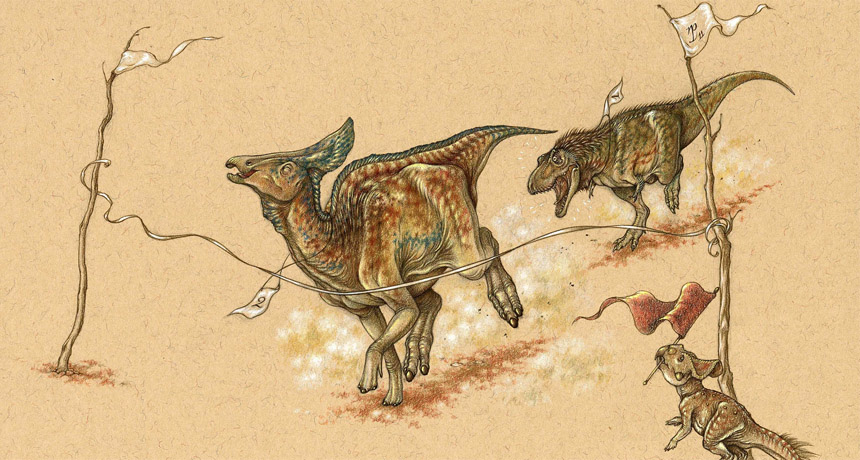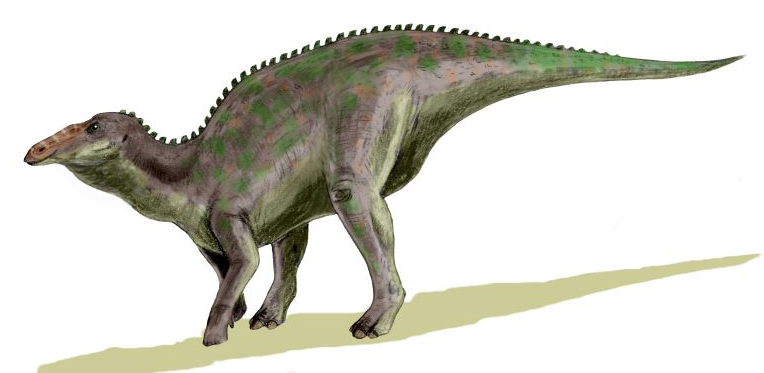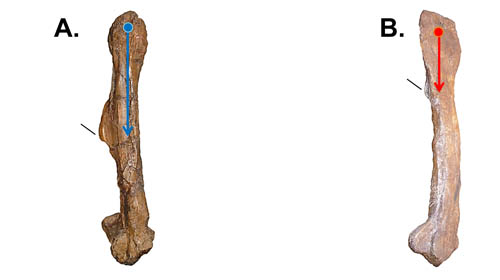Dinos: Some were ‘marathoners’
Duck-billed dinosaurs thrived by outrunning potential predators, new analysis suggests

Eat my dust! Over long distances, a duck-billed dino (depicted here in the lead) would have had the endurance to escape predators such as a tyrannosaur (background).
Niroot Puttapipat
Share this:
- Share via email (Opens in new window) Email
- Click to share on Facebook (Opens in new window) Facebook
- Click to share on X (Opens in new window) X
- Click to share on Pinterest (Opens in new window) Pinterest
- Click to share on Reddit (Opens in new window) Reddit
- Share to Google Classroom (Opens in new window) Google Classroom
- Click to print (Opens in new window) Print
By Sid Perkins
There’s an old saying about enemies: If you can’t beat ‘em, join ‘em. Evolution provided one type of dinosaur with a slightly different message: If you can’t beat ‘em, run!
Many dinosaurs had some type of defense against predators. Stegosaurs had spikes on their tails. Triceratops and its relatives had horns. Some species of the long-necked dinosaurs known as sauropods evolved to be so large that predators couldn’t successfully attack a healthy adult.
But hadrosaurs, commonly known as duck-billed dinosaurs, seemingly had no such defenses. Fossils suggest that they had no armor, no spikes and no horns. And they were about the same size or smaller than tyrannosaurs, their main predators.
Yet hadrosaurs undoubtedly were successful, notes Scott Persons. He works at the University of Alberta in Edmonton, Canada. As a vertebrate paleontologist there, he studies the fossils of creatures that had backbones. In many places in Asia and North America, he points out, hadrosaur fossils outnumber those of all other large dinosaurs combined.

Clearly, he concludes, “Hadrosaurs had to be doing something right.” But how did these plant-eaters, which possessed no apparent defenses, survive in a landscape full of big-toothed predators?
That’s a very good question, says Persons. To tackle this mystery, he teamed up with Philip Currie to study the well-preserved fossils of two hadrosaurs. Both had been unearthed in Alberta. They came from rocks that are roughly 75 million years old. One set of fossils came from an adult. The other dino had not yet fully grown up.
In general, a hadrosaur’s body resembled that of a tyrannosaur. Although a hadrosaur typically walked on all fours, it likely ran using its hind legs only. Tyrannosaurs were bipedal, meaning they moved solely on two legs. Both types of dinosaur relied on a big leg muscle called the caudofemoralis (CAW-doh-fem-or-AAH-lis).
That muscle gets its name from where it attaches to the skeleton, Persons explains. The upper end is connected to bones in the base of the tail. (In Latin, caudum means tail.) The lower end of the muscle is attached to the femur (FEE-murr), the large bone in the upper leg. When this big muscle contracted, it pulled the leg backward. That, in turn, propelled the animal forward.
But there was one key difference between tyrannosaurs and hadrosaurs: precisely where that big muscle attached to the femur.
In tyrannosaurs, it connected to the upper part of that leg bone. With one quick contraction of this muscle, the meat-eater could have made a long sudden stride. That’s a great benefit for a predator trying to ambush its prey. But being attached high on the femur also provided little leverage, says Persons. That means the tyrannosaur’s stride wasn’t very efficient. So, a run likely tired this hunter relatively quickly. You might therefore think of these beasts as sprinters.In hadrosaurs, that big muscle attached much lower on the femur. That required a longer muscle. And it would have contracted more slowly than in the tyrannosaur. So the hadrosaur wouldn’t have been much of a sprinter, Persons says. But the muscle’s lower femur attachment would have given it more leverage. That would have made the hadrosaurs’ strides more efficient. So these prey shouldn’t have tired nearly as quickly as their hunters.
In other words, the big plant-eater may have started running relatively slowly but probably would have been able to run for far longer than a tyrannosaur. So, if a hadrosaur escaped an initial ambush, it might have stood a good chance of outrunning its predator, Persons and Currie now conclude. Their analysis was published November 5 as part of a 36-chapter book on hadrosaurs.

The analysis by Persons and Currie “is a good solid preliminary study,” says Philip Manning. He’s a vertebrate paleontologist at the University of Manchester in England. He agrees that hadrosaurs probably had an advantage in long-distance running. But these dinosaurs also had a leg up on tyrannosaurs in other ways, he suspects.
Previous studies have bolstered the idea that hadrosaurs lived in large herds. With so many eyes and ears alert at the same time, it would have been difficult for a predator to sneak up on an entire herd. “That sort of behavior would be as good as any armor plate,” Manning suggests.
Holtz agrees: By traveling in large groups, he notes, one individual hadrosaur might be lost in a predator’s attack, but the rest of the group would survive.
Power Words
bipedal An adjective to describe an animal that walks on two feet.
caudofemoralis A muscle found in many creatures with a tail. It takes its name from the body parts to which its ends attach. In Latin, caudum means tail and femur means thighbone.
Cretaceous Period A geologic time period that included the end of the Age of Dinosaurs. It ran from roughly 145.5 million years ago until 65.5 million years ago.
dinosaur A term that means terrible lizard. These ancient reptiles lived from about 250 million years ago to roughly 65 million years ago. All descended from egg-laying reptiles known as archosaurs. Their descendants eventually split into two lines. They are distinguished by their hips. The lizard-hipped line became saurichians, such as two-footed theropods like T. rex and the lumbering four-footed Apatosaurus (once known as brontosaurus). A second line of so-called bird-hipped, or ornithischian dinosaurs, led to a widely differing group of animals that included the stegosaurs and duck-billed dinosaurs.
femur In humans, the large bone in the upper leg. It is commonly known as the thighbone. In tetrapods (creatures with four limbs), it’s the large bone in the upper hind limbs.
fossil Any preserved remains or traces of ancient life. There are many different types of fossils: The bones and other body parts of dinosaurs are called “body fossils.” Things like footprints are called “trace fossils.” Even specimens of dinosaur poop are fossils.
hadrosaur A duck-billed, plant-eating dinosaur that lived during the late Cretaceous Era.
paleontologist A scientist who specializes in studying fossils, the remains of ancient organisms.
predator (adjective: predatory) A creature that preys on other animals for most or all of its food.
prey Animal species eaten by others.
stegosaurs Plant-eating dinosaurs that had large, protective plates or spikes on their backs and tails. The best known: Stegosaurus, a 6-meter (20-foot) long creature from the late Jurassic that lumbered around the Earth some 150 million years ago.
tetrapod A four-limbed animal, including amphibians, reptiles, birds and mammals.
tyrannosaur A line of meat-eating dinosaurs that began during the late Jurassic Period, about 150 million years ago. These species persisted into the late Cretaceous Period, about 65 million years ago. The best known member of these species: the late Cretaceous’ Tyrannosaurus rex, a 12-meter (40-foot) long top predator of its time.
vertebrate The group of animals with a brain, two eyes, and a stiff nerve cord or backbone running down the back. This group includes all fish, amphibians, reptiles, birds and mammals.







